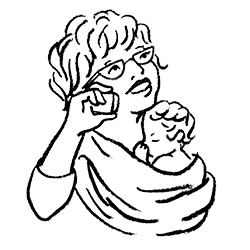COMMON CONDITIONS
How to Relieve Nipple Pain
summary
Nipples can sometimes become sore during breastfeeding although, it shouldn’t be so sore that you are wincing or thinking about it between feeds. Shallow latching, pump flange fit , infection, and anatomical anomalies are some common causes of nipple pain.
Equipment
• Expressed breast milk
• Nipple cream (options below)
• Moist wound healing products (options below)
• Proper fitting flange, if pumping
Steps
FOR SORE, RED, CHAPPED-FEELING NIPPLES While working on a deeper latch and ensuring your pump flange fits, here are some remedies that can provide pain relief. So long as your skin is not cracked, you can choose to try one of these ideas, or a combination.
• Olive or coconut oil: Try gently rubbing these oil onto the nipple to provide hydration. They have antibacterial and anti-fungal properties, and are easy to find in pantries and stores.
• Expressed breastmilk: Hand-express a small amount of breastmilk after breastfeeding and rub it on the sore nipple. Breastmilk contains antibacterial, anti-fungal, and antiviral factors that can help ease nipple pain.
• Commercial nipple butter/cream/lanolin: Apply a thin layer to nipples after breastfeeding with a clean finger. Be cautious of products that contain herbs, as they are not regulated for safety. This is not to be used if skin is broken because they can promote bacterial growth.
• Hydrogels: These can help by keeping the skin hydrated and providing a cooling feeling.
FOR NIPPLES WITH SKIN DAMAGE, CRACKING, BLEEDING, SCABBING OR BLISTERS
If breast tissue is broken, cracked, or bleeding, initiate wound care to prevent infection, then identify the cause of the damage. See your healthcare provider to prevent or heal infection. Your provider may recommend one of the therapies below or other products that promote moist wound healing such as polymem, medihoney, or hydrogel pads.
Broken skin that goes untreated can lead to a breast infection called Mastitis. As always, consult with your provider if you have health concerns and before introducing any new medication.
• Mild soap: For any wound, daily cleaning is essential. Wash nipples once daily with a mild soap and water. Dry gently.
• Antibiotic ointment: Once skin is broken, moist wound care is needed. Antibacterial ointment can prevent bacterial infection. Polysporin is safe to use during breastfeeding and is available over the counter. Do not use Neosporin. See your care provider to for Bactroban or other prescription strength options. In some cases oral antibiotic care might also be recommended.
• Prescription Nipple Cream: These treatments are used when a provider suspects multiple infections, including bacterial and fungal. Your healthcare provider will decide the appropriate prescription-strength treatment.
Follow up
If pain levels are not reduced using these measures, or you are noticing an increase in your symptoms please contact a qualified lactation professional and your healthcare provider for evaluation and assistance.
Are there any cures for sore nipples? by Marsha Walker, RN, IBCLC, RLC1
https://www.ingentaconnect.com/content/springer/clac/2013/00000004/00000003/art00003?crawler=true
Staphylococcus aureus and sore nipples
https://pubmed.ncbi.nlm.nih.gov/8653033/
Comparing the use of hydrogel dressings to lanolin ointment with lactating parents
https://www.ncbi.nlm.nih.gov/pubmed/12903698
This and other how-to guides are available as free downloads

